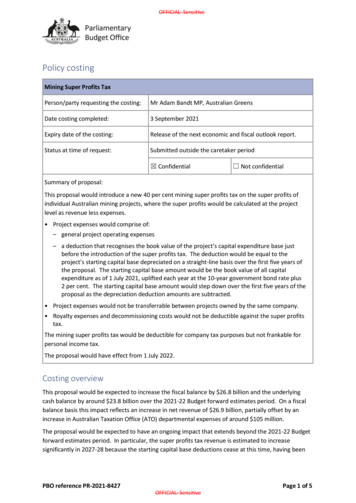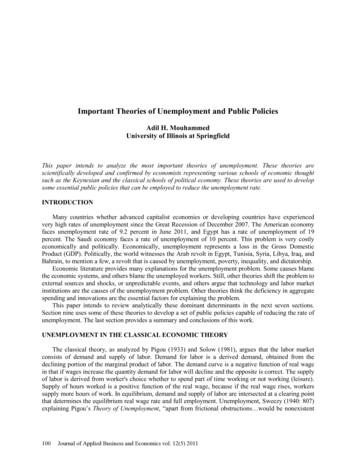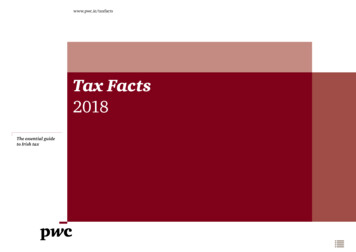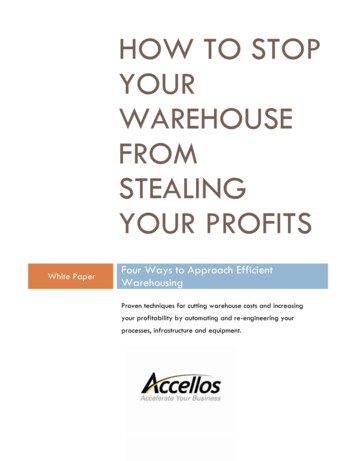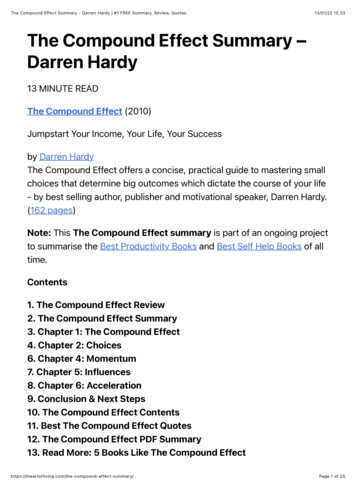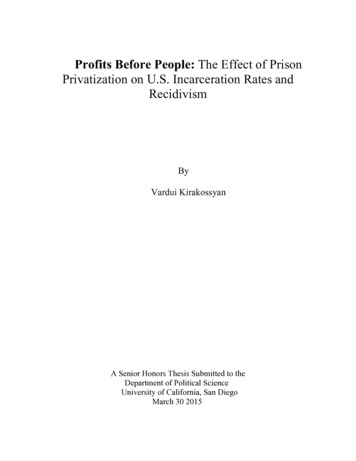
Transcription
Profits Before People: The Effect of PrisonPrivatization on U.S. Incarceration Rates andRecidivismByVardui KirakossyanA Senior Honors Thesis Submitted to theDepartment of Political ScienceUniversity of California, San DiegoMarch 30 2015
AcknowledgementsFirst and foremost, I would like to thank my advisor, Professor Peter Galderisi,for his incredible assistance and guidance throughout these two quarters. Without hisinsight and expertise, this paper would not have been made possible.I would also like to thank the UCSD Staff, including Professor Peter Smith andTom K. Wong, for ensuring all participants remained on track and for answering ourendless questions.My thanks to the statisticians at the Bureau of Justice Statistics who took the timeto reply to every single one of my emails and provide information when I had difficultyobtaining them.A special thanks to Annelise Skylar, the UCSD librarian, for her ability toaccommodate my last minute requests.I would finally like to thank my friends and family for their continuous supportand encouragement these past months.
In loving memory ofBella Kirakossyan
Table of ContentsChapter 1: An Introduction to the Prison System and Incarceration Rates1.1 Literature Review- Overview1.2 Design of Research5-88-1111Chapter 2: Incentive of Private Prisons2.1 Requirements of Private Contracts2.2 Political Gimmicks: Follow the Money2.3 Past Cases of Profit Motives2.4 Salaries of Executives12-1717-2121-2424-26Chapter 3: Private Prison Conditions and Recidivism3.1 Comparative Analysis: Minnesota3.2 Reported Issues3.3 Incentive to Recidivate27-3131-3636-37Chapter 4: Results:4.1 Thesis and Design Redefined4.2 Research Moving Forward38-4344-45Chapter 5: Conclusion45-47References48-49
CHAPTER ONE: INTRODUCTIONAmerica: the land of the free, home of the brave, and the nation with the highestrate of incarceration. It may come off as a revelation to most people when they discoverthat the country that advocates and is renowned for individual freedom and liberty,houses the highest proportion of its own residents in federal and state prisons than anyother country. The prison system has been a significant component in American historyfor centuries, gaining widespread development since before the American Revolution. Itserves many imperative purposes, the most crucial being public safety. By isolatingpotentially dangerous individuals from society and deterring others from committing actsof disobedience, prisons serve the critical function of maintaining peace and security. Butone wonders what it is that makes our prisons so populous and overcrowded.The United States amounts to five percent of the world’s population, yet houses aquarter of the world’s prisoners, according to the Economist. State and federal prisonpopulations have expanded fourfold between 1980 and 2008, increasing from half amillion in 1980 to more than 2.3 million in 2008 (Selman and Leighton 21). Figure 1.1demonstrates the progression of incarceration rates dating back from 1925. The trend wasrelatively stable, up until the 1970’s, when America saw an inflation that only continuedto expand. Figure 1.2 illustrates the sudden rise of the sentenced prison population fromthe late 1970’s up to 2012. For this reason, it is no surprise that these figures have led toserious issues of overcrowding and instability in American prisons.
Figure1.1Harrison, P.M. & Karberg, J.C. (2003). Prison and Jail Inmates at Midyear 2002.Washington, DC: Bureau of Justice StatisticsFigure 1.2Source: Bureau of Justice Statistics, National Prisoner Statistics Program, 1978–2012.The calculations are based on prisoners sentenced to at least one year. The data does notinclude transfers, escapes, and those absent without leave.
American prisons reached such high levels of overcrowding that the securenessand management of the prison systems were threatened. Prison conditions wereharshened and inmate riots began to emerge. Cases like Costello v. Wainwright(1975,1980) and Pugh v. Locke (1976) are just a couple cases of inmates challenging theproblems caused by overcrowding such as conditions of confinement, security issues andlack of sanitation (Selman and Leighton 41). It is not difficult to understand how limitedroom can lead to impactful circumstances for inmates.Due to the overcrowding and increased costs of incarceration, private prisonswere established as a solution. They offered alternative spaces that state prisons no longerhad and administered services in accordance with already existing public facilities. Butmany argue that they come with profit motives and incentives that aim to keepincarceration rates high. When prisons became overpopulated, investors saw this as anopportunity to create a business out of the prison system, thus creating the prisonindustrial complex. Private prisons are now given joint responsibility in the extremelycomplex duty of protecting the safety of both their inmates and of society.By understanding the underlying causes of our nation’s high rate of incarceration,figuring out effective solutions becomes more feasible. Evaluating private prisonmanagement can also provide insight on the quality of these institutions and further openthe door for scholars to make a conclusion about its pros and cons. In order to achieveprison reform and revoke America’s reputation of excessive incarceration, the treatmentof inmates as business objects needs further investigation. The central question thenbecomes: does the privatization of the prison system play a role in the heightened rate ofU.S. incarceration and recidivism? The incentive to arrest, to hold in longer captivity, to
create disincentives for rehabilitation and thus increase recidivism, and to minimizespending as much as possible, are key driving forces in optimizing profits. Since potentialinmates are the form of revenue that is required for private prisons to stay in business, Iargue that privately owned/operated prisons have a primary goal of obtaining the highestnumber of inmates they can. Increasing or maintaining high recidivism rates is essentialbecause that means incarceration rates are also staying high or increasing. Preventing thedecline of recidivism ensures the promise for potential inmates. The simple rationaletherefore becomes, the more inmates incarcerated, the more profits acquired.Research has been conducted on the effect of state and federal prisons on societyand crime rates, yet there is limited research on the effects that the private prison systemhas on recidivism and incarceration rates. In this research, I aim to begin an investigationof the causal role that private prisons play in expanding these rates. In particular, I willhypothesize that recidivism rates are higher for prisoners that were housed in private thanin public prisons, especially when controlling for the different mix of types of crimescommitted by inmates in different types of facilities.1.1 LITERATURE REVIEW-OVERVIEWThe prison industrial complex, “a set of bureaucratic, political, and economicinterests that encourage increased spending on imprisonment, regardless of the actualneed” (Schlosser), has led to a rapid development of prison facilities in the United States.The 35 billion spent each year on corrections is not deemed as excessive or burdensomeon American taxpayers, but is considered as a profitable enterprise.
Currently, there are approximately 100,000 individuals held in private prisons innearly 102 privately operated or owned facilities in the United States (Coyle, Campbell,and Rodney 39). The rapid expansion of the private corrections industry demonstratestroublesome consequences that affect society as a whole. Current debate surrounds thenotion of harsher sentencing laws leading to increased incarceration, but what has failedto be mentioned is the incentive behind harsher sentencing laws. The profit motive ofprivate prisons could be at least partially responsible for stricter sentencing laws,especially for lower offences, in order to convict more inmates and thus lead to a highrate of incarceration. Private prison corporations and political officials have alignedinterests in keeping incarceration at high rates through harsher sentencing laws in order tosave money and make profits. Because private prisons contract with states on the basis ofbeing more cost-efficient, states agree to invest in these facilities in order to save money.Prominent legislation such as the Comprehensive Crime Control Act and the SentencingReform Act, which were passed by Congress in 1984, eradicated federal parole andinstituted mandatory minimum sentence laws for various drug offenses (Coyle,Campbell, Rodney 42). By revoking judges’ discretion in making sentencing decisionsfor crimes, private prisons end up determining the availability of their potential“customers”.Literature on private prison contracts exemplifies the essentials and requirementsof what these corporations need to reach a binding decision. The mutual agreement toinvest in the privatization of the prison system plays a key role in illustrating the rationalebehind the decision-making. The dilemma is that private companies demand the inflatedrates of incarceration and overcrowding in order to remain and strive in business (Selman
and Leighton 92). One of the most profitable and leading private correctional companies,Corrections Corporation of America, states in their annual reporting that their growth isdependent on a number of uncontrollable variables, including sentencing routines indiverse jurisdictions. According to the language of their 2008 annual report, “any changeswith respect to drugs and controlled substances or illegal immigration could affect thenumber of persons arrested, convicted, and sentenced.” By examining the languagebehind the contracts and reports of these private corporations, the influencing factorsbehind profit maximization become more recognizable. If the growth of prisoners createsgrowth of revenue, then it is only logical that a company will aim to achieve aneconomically sufficient number of arrests and rearrests.An area of this field that requires more emphasis is the management of privateprisons. The use of empirical evidence to compare public and private management ofprison facilities has been. A large part of the problem, as I have discovered, is the lack ofa long term and consistent database from which to test causal effects. The firstprivatization of prisons did not occur until 1983 and a systematic study of recidivismrates has never been conducted.An essential duty of prison facilities is to rehabilitate inmates in hopes of allowingthem to return to their communities as functioning members of society, and prevent thoseinmates from returning into the system. Yet there are a limited number of contributionsby economists on the direct evaluation of rehabilitation programs (Avio 152). Evidenceexits that the finances required for rehabilitation and to prevent recidivism has beenreduced systematically by prison firms. Yet studies that examine the effects of decreased
investment in rehabilitation, particularly in private facilities, is limited and their resultsare often contradictory.1.2 DESIGN OF RESEARCHIn this study, both the assumptions behind my hypothesis that the incentives inherent withprivatization lead to increased incarceration and, in turn, recidivism rates, and the linkbetween privatization and recidivism will be examined. The assumptions will mainly bestudied through a detailed review of the existing literature on incentives and how they arecarried out. To test the hypothesized link, a more consistent statistical analysis will beemployed.
Chapter 2: Incentives of Private Prisons2.1: Requirements of Private ContractsA vital way of understanding the intent and of private prisons is by focusing onthe contracts they enter with states to house inmates. Since contracts represent a mutualagreement, they allow readers to understand the underlying goals and incentives directlythrough the language of these private prison corporations. Under practically all contracts,private prisons acquire a fixed sum per inmate per day. This fee is referred to as ‘perdiem’ and the per diem for a single inmate is referred to as compensated man-day(Selman and Leighton). Evidently, revenue and profits are at a maximum when prisonshave full occupancy. The IPO of Wackenhut, America’s largest private securitycompany, explained, “Under a per diem rate structure, a decrease in occupancy ratescould cause a decease in revenue and profitability” (Cornell 1994). With this businesslogic, inmates are treated as customers, who are essential for the continual operation ofthese privately owned corporations. Similar to an ordinary business model: the morecustomers, the more revenue. Thus, the more prisoners private prisons house, the morerevenue they generate.CompensationGetting hands on private contracts made with states is a task that requires a greatdeal of time and the seeking of formal requests, thus making an on time delivery for thispaper impossible. Luckily through literature, contract analysis can still be achieved tosome extent. One of the most essential components of private prison contracts is that ofcompensation. The norm has become a guaranteed minimum payment to private prisoncorporations, regardless of the actual amount of inmates (Selman and Leighton). This
means that regardless if a bed is filled or not, a mandatory amount of inmatecompensation must be provided on behalf of the state. It is logical to assume that sincestates are paying for the prison space anyway, they would want to utilize it, or at leastwould not feel compelled to prevent using it. The usual occupancy rate is about 80% andeven extends to a full 100% in many cases. Three prison contracts in Arizona havemandatory occupancy rates of full 100%. Oklahoma has three contracts guaranteeing98% occupancy rates (Kroll 2013). When applying economics of scale, the rise ofoccupancy rates is accompanied with lower operating costs per resident, according toCornell’s 2008 annual report (Selman and Leighton). Not only do more inmates lead tomore revenue, but also to a reduced cost of operation per inmate. This means that privateprisons depend on government for more inmates since those are the terms of the contract.When examining earlier contracts made with states, they usually lasted aroundtwo to three years. After each year, compensation per diem increased anywhere from twoand a half percent to six percent (Selman and Leighton). At first, adjusting forcompensation was based on fluctuations in prices for all goods and services in the U.S.economy, also referred to as implicit price deflator (IPD). In 1994, these circumstancesbegan to change. Contracts demanded a period of five years on average and requiredannual increases of three to four percent; they no longer used IPD as a measure. Datingback as early as 1988 up until 2005, we even saw private prison companies usingstrategic methods to achieve their profit incentive. They determined a way to eliminatecompetition amongst other private facilities and even government agencies. CCA createda new clause indicating that when officers decided to house an inmate in their localpublic jail when an open bed was available in a private institution, even if it is just for a
single night, the county would have to compensate to the company as if occupancy rate ofthe company was completely full.These strategic clauses made their way into the norm of private corporations andstate contracts as states became more and more invested into privatization. Languageexplicitly written in contracts with CCA states, “The Country agrees it will not houseinmates eligible for commitment to the CCA, so long as the Detention Facility operatedby CCA is not at capacity If additional Detention facility capacity is constructed for theCounty, both CCA and the County shall have the option to add the management of suchadditional capacity to this contract” (1998, 2005). This means that any extra constructionof prisons will have to be shared amongst both the County and the private prison. Directquotes from these contracts illustrate the incentive these companies have to make moneyand demonstrate the risks involved if suddenly less Americans were arrested.Government must work alongside with private prisons in order to keep up withcontractual agreements. Fortunately for them, they found a way to control for thesepotential risks by securing the minimum guaranteed compensation clause, which initiatesthe county to pay regardless of the amount of inmates housed. Counties now have interestin sending arrests to private facilities to avoid paying a fee and keeping up with thearrangements.Facility MaintenanceStraying away from rental proceeds, another important aspect of contracts thatportrays the primary rationale of profits is facility maintenance. Logically, if businessescan reduce costs, they can increase profits. This business reasoning is evident withprivate prisons as they promise to offer a less costly method for housing inmates. Facility
maintenance is a major component when operating prison facilities, which is why privateprison companies appeal to states by asking for a lower per diem maintenance fee thanwould be necessary in a public prison facility. What ends up happening at times however,is companies overcharging government and spending less of their appropriated sum onfacility maintenance. In a contract between CCA and Florida, CCA only spent 175,000out of the billed 645,000 annually on facility maintenance. Over a five-year period, thecompany ended up overbilling the government approximately 2.85 million (Selman andLeighton, 116). Accordingly, we see facilities being neglected, like the case of TulsaCounty in 2005. In this predicament, CCA’s contract was terminated due to poor facilitymaintenance, which required a minimum of 250,000 in repairing costs. Situations suchas these demonstrate the primary motive of private prisons, which is operating in amanner of maximizing profits regardless of the consequences it may impose on society.Moreover, contract monitors are a crucial aspect in contract agreements. Contractmonitors are responsible for facility inspections, whether they are on-site or frequentvisitors. Contract language promotes monitors to pay close attention to the companiesthey are assigned to, but it does not ensure complete compliance. How is this so?Discovering examples of breaching monitoring duties explain how contract compliance isnot a top priority for many prisons. For instance, a private juvenile prison in Texas,operated by GEO group, had high reports of prison mismanagement and harsh conditions(further described in the next chapter). After closer examination, it became evident thatseventy-five percent of the contract monitors for the prison site were actually formerGEO employees. The obvious conflict of interest that prevails in this situation benefitsthe company because low maintenance can be considered acceptable for a period of time,
until the violations get discovered of course. When prison owners are still compensatedfor unsatisfactory treatment of facilities, it becomes obvious that the comfort of inmatesis not of primary concern.StaffingFinally, agreements for staffing of private companies exist within all contractssigned by state and private prisons. These requirements vary with background checks,minimal number of mandatory staff, and training standards. The purpose of having staffmembers is to promote stability, safety, and order in these especially dangerous settings.Disappointingly, we see cases of understaffing, overbilling, and increasing “ghostemployees” (Selman and Leighton, 120). Ghost employees refer to “billing a state forvacant positions” (120). Generally, staff is hired based on a staff per inmate ratio. It is inthe clear interest of companies to hire less staff per inmate as a method of saving moneyand overbilling as a method for making money. Even the language within these contractsdoes not guarantee compliance to background checks. Specifics about what is and is notacceptable is not transparent and private companies obtain great amount of discretion intheir hiring process, unlike public institutions. An audit conducted from 2003 to 2005 ona GEO corporation revealed about one hundred employees being hired withoutunderdoing a criminal background check (Selman and Leighton, 120). Having lowbarriers of entry for employees allows inexperienced staff members to perform thedifficult tasks that require experience and skill. It goes without being said, monetarygreed is the basic root of essentially all decisions made by private prison corporations.Private prison and public state contracts portray how little the public is actuallyinvolved in the decision-making process, which seems ironic since it is the public that is
being housed in these facilities. With no care for inmate input, accountability isimaginary and incentive for change is nonexistent. The strategic thought processes thatexist with private prison corporations are all geared towards reducing costs as much aspossible, to save as much as possible, and essentially profit as much as possible. It issurprising how America can allow for companies with great discretionary powers,minimal oversight, and low accountability to exert such huge influence on society.2.2 Political Gimmicks: Follow the MoneyPolitical EndorsementsAfter analyzing the private and public partnership within the contracts of prisonsand government, we see how an environment behind closed doors is created, where thepublic has no say and probably no knowledge of what is actually occurring. What ends upbeing created is an “iron triangle”, where government, key legislative members, and theinterests of greedy corporations are safeguarded from external pressures anddependability. “When the members of the iron triangle get together, a sub-government isestablished that has the capacity to create public policy that is distant from publicscrutiny” (Adams 1984). Just picture the amount of influence three extremely powerfulfigures working together can have on society in terms of economic, political, and socialissues. Sentencing policy can be shaped primarily on a cycle of figures that represent themonetary interests of private prison corporations.This produces a system where the government benefits from lower operationalcosts of housing inmates, private prisons benefit from extensive profits, and legislaturesreceive political donations and campaign contributions, while the public faces a greaterrisk of mass incarceration. The unification of these major parties: government and private
corporations, leaves minimal room for public or third party influence. This partnership isevident by simply viewing the annual reports of private prison corporations. GEO group,one of the world’s leading providers of correctional housing and services, has its topexecutive members as former government employees. For example, Norman A. Carlson,member of the board of directors at GEO, is a former director of the Federal Bureau ofPrisons. Ann N. Foreman, also a member of the board of trustees, is a former UnderSecretary in the United States Air Force (2012 GEO Annual Reporting). The boardchairman and Chief Executive Officer at CCA, a leading private prison corporation, wasonce the Commissioner of Finance for Tennessee.As long as private prisons operate in society and contract with states, lobbyingwill only become more and more frequent. For example, Betty Anderson, politicallobbyist for Correctional Corporations of America, was wife of Speaker of the House inTennessee General Assembly. Also, Governor Donald Sundquist’s former chief of staffhad been advising the Governor on prison privatization while simultaneously a CCAstockowner (Selman and Leighton, 97). From 1994 to 1996, Tennessee had a statute thatpermitted only one private prison operating at a time. Controversially, GovernorSundquist endorsed a scheme for CCA to contract for construction of another privateprison, financed with state bonds of 47 million. What can be a reasonable explanationbehind this decision-making? Well, this endorsement took place after a donation amountof 60,491 was given to Tennessee lawmakers by the founders of CCA, 38,500 ofwhich was donated to the reelection campaign of Governor Sundquist. This is just asingle example of corporate owners lobbying their way to achieve means of massincarceration by paying their way to get what they want, profits.
Figure 2.1. CCA Funds Spent on Federal Lobbying (Sentencing Project)Since 1999, CCA has spent an average of 1.4 million on in-house lobbying eachyear and since 2004, CCA’s political action committee has contributed over 130,000 onaverage for each election cycle on federal candidates. Private prison corporations use astrategic business model for generating profits, and in turn use that money to lobby andcreate incentive for legislatures to work with them as a team, in order to make even moremoney. Routinely, CCA and other private prison corporations have favored donating toRepublicans, primarily for their conservative take on crime and punishment. Interestinglyenough, CCA’s scope of influence still extends to Democrats who have received abouttwenty percent of the company’s federal contributions.Teaming Up With LawmakersAlthough private prisons argue that they do not endorse longer sentencingpolicies, it would be naïve to simply believe their line of defense. The interest privateprisons have in influencing legislation becomes evident when we see them forming
relationships with legal associations. For example, The American Legislative ExchangeCouncil, an organization for conservative legislatures advocating free markets andindividual liberty has also teamed up with CCA. This corporate lobby and privatebusiness partnership introduces dangerous possibilities to society, where both parties canmake an exchange in light of pursuing their own interests. Paying councils a sum ofmoney for “ghost writing” legislation in favor of their businesses becomes a plausibleexpectation (Selman and Leighton). By being a member of ALEC, private prison ownerscan discuss the benefits of their prison system to state lawmakers, who in essence canadminister laws that are skewed towards the private interests. This basically means thatthe process of administrating criminal justice law takes place behind closed doors andmost importantly, far away from public scrutiny. What is even more surprising is thatprivate businesses can pay for a seat on ALEC’s Criminal Justice Task Force, whichcreates “model” bills on criminal punishment. Tracking the progress of this task forceillustrates the tough on crime agenda that is promoted by the organization. The mostimportant model bills that were created in this sector include three-strikes laws, theHabitual Juvenile Offender Act, The Truth in Sentencing Act, and mandatory minimumsentencing laws. Logically, private prisons have an incentive to lobby for harshersentencing laws for petty/non-serious crimes. If non-serious crimes become associatedwith stricter sentences, then the demand for private prisons would increase since thenumber of arrests would also increase. It is simpler to amend laws for nonviolent or nonserious crimes since there is a consensus on harsher punishment for serious crimeviolations
These laws have become widespread across many states where criminal offendershave started to receive little leniency for their violations. Although this seems unfair tothe public, who may receive an extraordinarily long sentence in accordance to minor drugviolations, it is still beneficial to corporate executives who now have more inmates tohouse. Some may argue that the increased rate of incarceration has lead to the need forprivate prisons, but once these facilities are established, there is a new incentive to keepincarceration rates high instead of reducing them. For this reason, this paper focuses onthe concept that prison privatization plays a role in maintaining the inflated rates ofincarceration in the US. Incarcerating more people can be perceived as reducing crime onstreets, but it is also another way of reducing business risks for these corporations andincreasing profits. “The problem is that companies need the current elevated rates ofincarceration and overcrowding to continue indefinitely” (Selman and Leighton). Ifincarceration rates decreased and public prisons began to have vacancies, private prisonswould lose their business due to reduction of demand. The prison-industrial complex hasbecome a system of pursuing greedy interests at the expense of the citizens who makemistakes with the law.2.3: Past Cases of Profit MotivesCash for Kids ScandalTo the general public, the details of corruption and bribery are generally not heardof. With further research, one will discover the various cases of how private corporationscan influence even the most powerful figures into acting on behalf of business interests.A very relative and astonishing case is referred to as the “Cash for Kids” scandal. In this
2009 case, Pennsylvania Judge Mark A. Ciavarella, sentenced over two thousandadolescents to jail for petty crimes. One of those minors was Hillary Transue, a fourteenyear old teenager who created a fake MySpace page of the vice principal of her school.Another was Justin Bodnar, who was sentenced to juvenile detention for cursing at themothers of another student. There was also Ed Kenzakoski, a seventeen year old that wasdiagnosed with ADD before the age of ten and began drinking at the age of fourteen. As away of scaring Ed and putting him on the right track, his father with the help of twoofficers, placed a marijuana pipe in the boy’s truck so when officers pulled him over hewould be scared enough to turn his life around. Af
Washington, DC: Bureau of Justice Statistics !!! ! ! ! ! Figure 1.2 Source: Bureau of Justice Statistics, National Prisoner Statistics Program, 1978-2012. The calculations are based on prisoners sentenced to at least one year. The data does not include transfers, escapes, and those absent without leave. !



